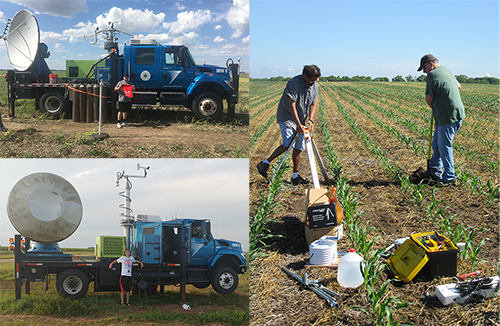WKU News
WKU researchers part of study on irrigation's impact on precipitation
- WKU News
- Monday, August 13th, 2018

WKU researchers gathered data this summer in Nebraska as part of the Great Plains Irrigation Experiment. Top left: C.J. Padgett participated in the first observation period in late May and early June. Bottom left: Brandon Wasilewski participated in the second observation period in July. Right: Scientists Udaysankar Nair (left) of University of Alabama at Huntsville and Eric Rappin (right) of the Kentucky Climate Center at WKU installed a weather station as part of the GRAINEX project.
WKU meteorology students and a Kentucky Climate Center scientist have been gathering data this summer in Nebraska as part of the Great Plains Irrigation Experiment (GRAINEX), a National Science Foundation-funded research project to further understand how irrigation may be affecting precipitation.
The project highlights the engagement of the Kentucky Climate Center and WKU students in research that links land use and atmospheric processes, leading to a better understanding of climate.
Agricultural irrigation to meet a growing demand for food is adding significant amounts of water to the land surface and altering regional land use and land cover. Such changes impact circulations of the lower atmosphere, potentially influencing cloud development and precipitation.
Scientists from WKU and five partner institutions -- the University of Nebraska-Lincoln (UNL), University of Alabama at Huntsville (UAH), University of Colorado at Boulder (CU), National Center for Atmospheric Research (NCAR) and the Center for Severe Weather Research – collected data in June and July across a 3,600-square-mile area in southeastern Nebraska, one of the most irrigated areas in the world.
The results of the study will help agricultural planning and weather forecasting in the United States and other parts of the world, the researchers said.
“Prior studies have found that the Great Plains is a hotspot where soil moisture plays an important role in cloud formation and precipitation,” said Nick Anderson, a program director in NSF's Division of Atmospheric and Geospace Sciences, which funded the research. “Changes in land use and irrigation for agricultural activities could be important in land-atmosphere interactions in this region. The results from this study will be valuable to our understanding of the link between irrigation and precipitation.”
Dr. Eric Rappin, Research/Application Scientist with the Kentucky Climate Center at WKU and one of the project’s co-leaders, is in charge of the modeling effort of conditions in the boundary layer of the lower atmosphere.
“What we want to do is model that daily behavior because it’s very important how the land surface interacts with the lowest part of the atmosphere. That’s where weather comes from,” Dr. Rappin said.
Dr. Rezaul Mahmood, director of the High Plains Regional Climate Center at UNL, is leading the project. Other co-leaders are Udaysankar Nair of UAH and Roger Pielke Sr. of CU.
“We designed this research project to take place over a two-month period to allow us to understand the impacts of irrigation right when it begins, and during its maximum application in mid- to late July,” said Dr. Mahmood, former associate director of the Kentucky Climate Center and Kentucky Mesonet at WKU. “The study includes the transition region between extensively irrigated areas and dry land or non-irrigated areas. The experiment's setting offers a unique opportunity to investigate the influence of these different land surface and land cover regions side by side.”
WKU students C.J. Padgett, a senior from Belleville, Illinois; Brandon Wasilewski, a senior from Clinton, Tennessee; Justin Hobbs, a senior from Irvington; Luke Rogers, a senior from Lanesboro, Minnesota; Lindsey Byrd, a senior from Science Hill; Austin Deering, a junior from Bowling Green; and Ben Ellzey, a junior from Florence, participated in the observation periods this summer and helped collect data.
The on-site field experiment work is “great experience for them to have and it really piques their interest in the field of meteorology,” Dr. Rappin said. “And it helps because WKU has one of the strongest programs in the region.”
The GRAINEX project includes deployment of 75 meteorological stations and several different methods to collect data:
- Measurements of fluxes of water and energy from six irrigated and six non-irrigated locations.
- Radar observations of the lower atmosphere from three locations.
- Weather balloon-based observations of the atmosphere from five locations.
- Two surface locations with a series of instruments that collect data on the lower atmosphere.
These data will be analyzed and used, along with model applications, to determine the impacts of irrigation on precipitation in the Great Plains. The team will use NCAR’s supercomputing facility, in addition to computational facilities at WKU, UAH and UNL, for the modeling.
Contact: Eric Rappin, (270) 745-2354
Some of the links on this page may require additional software to view.

